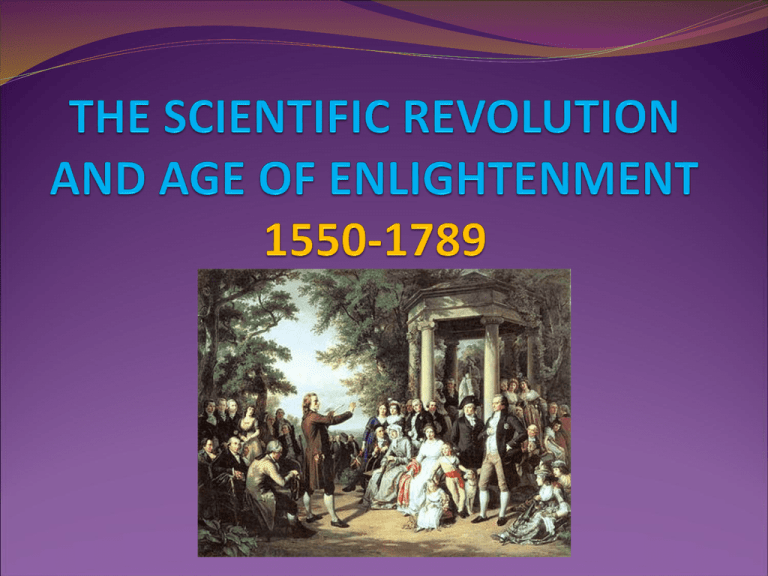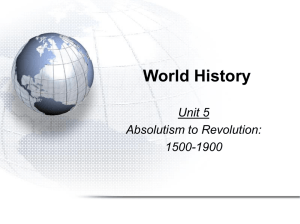(The Scientific Revolution and Enlightenment)
advertisement

SCIENTIFIC REVOLUTION The Scientific Revolution had the greatest influence on the Enlightenment ideas of natural law and reason Scientists questioned traditional beliefs about the universe Observation and experimentation were central ideas COPERNICUS AND GALILEO Galileo Galilei’s observations supported the theories of Nicholas Copernicus They were both astronomers who supported the heliocentric theory (planets revolve around the sun) Their ideas developed into the scientific method (logical procedure for gathering and testing ideas) HELIOCENTRIC THEORY SCIENTIFIC METHOD ENLIGHTENMENT IDEAS Central belief = the use of reason would lead to human progress Philosophers of this period believed society could be best improved by applying reason and the laws of nature Similar to the Scientific Revolution because this movement encouraged the spread of new ideas Similar to the Renaissance because a new questioning spirit and attitude emerged ENLIGHTENMENT POLITICAL VIEWS European political thinkers who supported this movement believed governments should protect the rights of people They also supported representative democracy Writers during this period wanted to change the relationship between people and their government JOHN LOCKE Important Enlightenment philosopher from England Believed the purpose of government was to protect the natural rights of people (life, liberty, property) Governments should be based on the consent of the people He directly influenced the following phrase located in the Declaration of Independence: “We hold these truths to be self-evident, that all men are created equal…” BARON DE MONTESQUIEU Enlightenment philosopher who wrote The Spirit of Laws He believed in separating the government into three branches: legislative, executive, and judicial Three branches of government would prevent tyrants from rising to power ENLIGHTENMENT PHILOSOPHERS John Locke, Baron de Montesquieu, Jean Jacques Rousseau, and Voltaire all believed in establishing a democratic republic (people elect their leaders) Their ideas influenced movements for political reform and revolutions in Europe and the Americas SCIENTIFIC REVOLUTION Scholars in Europe during the mid-1500s replaced old assumptions with new theories This was a new way of thinking about the natural world New way = careful observation and a willingness to question accepted beliefs HELIOCENTRIC THEORY Presented by Polish astronomer Nicholas Copernicus Heliocentric Theory = the stars, Earth, and other planets revolved around the sun This challenged the geocentric theory that stated all heavenly bodies revolved around the Earth Geocentric theory was supported by Greek philosopher, Aristotle, Greek astronomer, Ptolemy, and Christianity GALILEO GALILEI Italian scientist who built upon Copernicus’ ideas about astronomy He built and used his own telescope in 1609 to study the heavens Discovered 4 moons orbiting Jupiter, the sun’s dark spots, and the moon’s surface was rough and uneven In 1633, he was forced to confess to the Catholic Church that the ideas of Copernicus were false, otherwise he would have faced torture SCIENTIFIC METHOD Developed by Francis Bacon and Rene Descartes Modern scientific methods are based on their ideas Scientists have shown that observation and experimentation, together with general laws expressed by mathematics, can help people better understand the natural world Scientific Method = observation-> question-> hypothesis-> experimentation-> conclusion ISAAC NEWTON English scientist who discovered the law of universal gravitation Law = all physical objects are affected equally by the same force; this force ruled the motion of the planets and all matter on Earth and in space Every object in the universe attracts every other object The degree of attraction depends upon the mass of the objects and the distance between them He believed that God created the universe to function perfectly according to mathematics THE ENLIGHTENMENT This was a revolution in intellectual activity that changed Europeans’ view of government and society Scientific Revolution led to the Enlightenment which was a movement stressing the use of reason and logic The literate middle class, thinkers and artists, and American colonists were all influenced by this movement THOMAS HOBBES English political thinker who distrusted humans and favored a strong government to keep order In his book Leviathan (1651), Hobbes promotes social contract, which is achieving order in society by giving power to an absolute monarch JOHN LOCKE English philosopher who criticized absolute monarchy Consent of the Governed = he proclaimed that governments get their power from the people Stresses that people have a right to overthrow an unjust government Natural rights = he believed that all people are born free and equal and have the right to life, liberty, and property His ideas directly influenced the American Revolution and our Constitution PHILOSOPHES Philiosphes is the French word for philosophers They believed progress (improvement) for society could be achieved through reason, nature, happiness, and liberty Salons = regular social gatherings where philosophers, writers, artists, and scientists met to spread Enlightenment thinking; began in Paris VOLTAIRE French philosopher who fought for tolerance, reason, freedom of religious belief, and freedom of speech Made powerful enemies and was imprisoned twice for his views His view on religious freedom directly influenced our First Amendment in the U.S. Bill of Rights BARON DE MONTESQUIEU French writer who favored separation of powers to keep one body from completely running a government He believed in three branches of government – legislative, executive, and judicial In his book, On the Spirit of Laws (1748), he explains the concept of “checks and balances” JEAN JACQUES ROSSEAU Believed that civilization corrupted people’s natural goodness He believed that the only good government was one that was freely formed by the people and guided by the “general will” of society His book, The Social Contract (1762), explains the idea of a direct democracy NEOCLASSICAL STYLE Pre-Enlightenment art style was baroque - grand and ornate designs (over-the-top) Enlightenment style was neoclassical, which emphasized elegance and simplicity New style was based on Greek and Roman themes Classical music emerges – lighter and more elegant than earlier style; led by composers such as Haydn, Mozart, and Beethoven ENLIGHTENED DESPOTS Monarchs who embraced Enlightenment values to strengthen their rule Frederick II - king of Prussia (1740 to 1786); reforms education and justice system, grants freedom of worship, and abolishes torture Catherine the Great – ruler of Russia (1762 to 1796); she responded to a peasant revolt by giving nobles more power over serfs and successfully expanded the Russian empire by seizing northern coast of Black Sea and large parts of Poland AMERICAN REVOLUTION Enlightenment ideas swept through Europe as well as colonial America The spirit of questioning during the Scientific Revolution influenced the American Revolution because it led to challenging ideas about government After England passed the Stamp Act in 1765, American colonists accused Parliament of “taxation without representation” which was a violation of their “natural rights” The colonists won the American Revolution (1775 to 1781) due to a strong motivation to fight for their land, mistakes made by British generals, guerilla warfare, and the British having to fight an overseas war DECLARATION OF INDEPENDENCE Written by Thomas Jefferson and issued on July 4th, 1776 Colonial leaders used Enlightenment ideas to justify independence John Locke’s natural laws of life, liberty, and property, as well as the pursuit of happiness, were incorporated into the actual document ARTICLES OF CONFEDRATION In 1781, the original 13 States created a government with a legislature only (Congress) and no executive or judicial branches Result was a weak national government that failed to provide unity and order UNITED STATES CONSTITUTION Leaders call the Constitutional Convention in 1787 to revise the Articles In 1787, the Constitution creates three branches of government Provides checks and balances - ensures branches share power equally Promotes federal system - power divided between national and state governments BILL OF RIGHTS Some Americans feared too much national power and few protections of rights Leaders won support for creating a new Constitution by adding a Bill of Rights (completed in 1789 and ratified in 1791) Bill of Rights = the first ten amendments to Constitution that protect human freedoms and civil liberties The Bill of Rights was influenced by John Locke, Voltaire, and Rousseau











